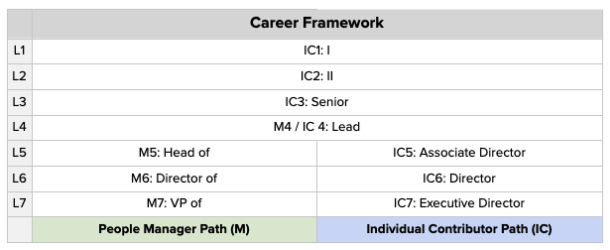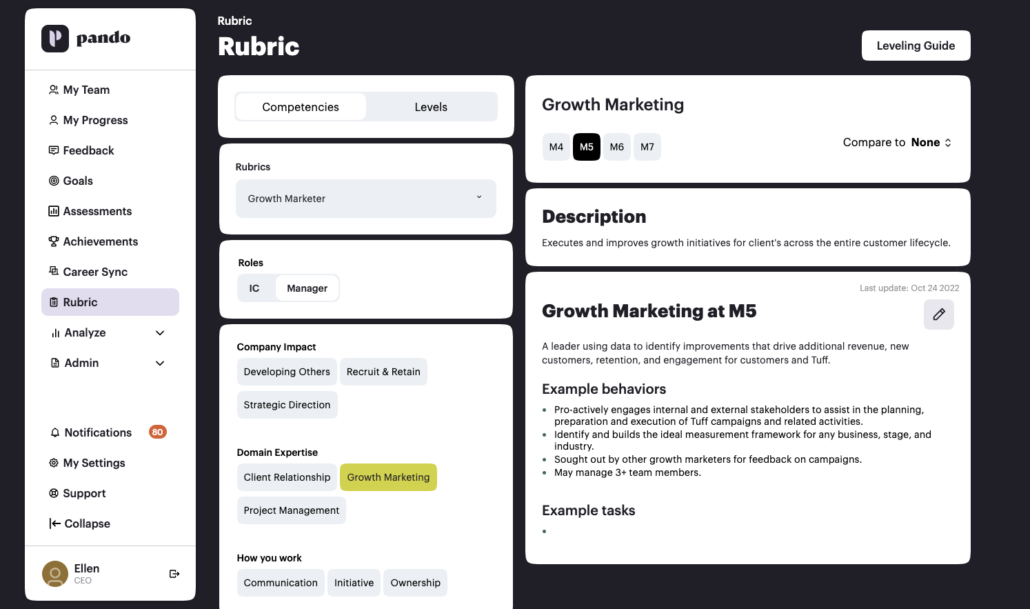How We Created a Career Framework For Growth on a Performance-Based Marketing Team [Updated]
This was last updated on November 8, 2023 with new links, information, and data on our current career framework and approach to career development.
Tuff is committed to building a high-performing team focused on balancing individual and company growth. We have always believed it is important for the individuals at Tuff to grow alongside each other and our business.
To support these behaviors, we created a career framework with 7 Levels, 2 Paths, and 3 Steps. By offering a clear vision of what the future holds for each individual within our framework, we ensure that no one is left uncertain about their path and how to contribute effectively. This transparency not only helps reduce pay disparities but also boosts employee retention, which is a pivotal aspect of our effort to establish an equitable compensation program and creating a place where people are inspired to do their best work.
In this post, we’ll dive into the career framework and the steps we’ve taken to build ours at Tuff.
Creating a Career Framework
Here are the steps we took to build ours:
- Define our compensation philosophy
- List out your Company Roles
- Create your Career Framework matrix
- Define the Levels for each role and the Steps for your company
Okay, now for the nitty-gritty. Here’s how to apply each step and what it looks like at Tuff:
1. Outline your compensation philosophy
A Compensation Philosophy is an explicit overview of a company’s views and decisions about total compensation. In job descriptions, you may have seen statements like “we pay 50th percentile” or “we don’t adjust pay based on location”. These are compensation decisions in action that are based on that company’s philosophy on pay.
The type of company and culture we’re building is a reflection of each individual that works at Tuff. As we grow and our team evolves, so will our practices and policies. Our Compensation Philosophy is a reflection of where we are today but it is living and breathing and we may make updates in the future. We strongly encourage team members to ask questions about our approach to compensation.
Having our Compensation Philosophy principles explicitly outlined and agreed upon keeps our Career Framework consistent and systematic while also giving the team a shared understanding of how compensation decisions are made. Our Compensation Philosophy is intended to ensure our compensation decisions are:
- Equitable among employees, positions, and locations
- Supportive of our core business objectives
- Competitive with our market
- Easily understood by every team member
There are two sets of clients at Tuff: the companies that we partner with and the employees of Tuff. For both of these groups, our goal is healthy and sustainable growth. In our approach to compensation, we borrow a lot of the same principles that have lead to growth with our clients.
We’re transparent
Since day 1, we’ve prioritized internal financial transparency. We give team members access to base salary data for every role at Tuff because it is important for everyone to understand their compensation options.
We’re consistent
We have a standard Career Framework so each team has the same number of Levels and paths for growth. Using our Career Framework, every possible Level for every possible role at Tuff has a standardized base salary. This means we don’t adjust pay based on who negotiates and who doesn’t. We also don’t adjust salary based on location because team members provide equal value to Tuff no matter where they log in from.
We’re data-informed
Pay transparency reduces pay gaps and improves employee retention. We will always look to data to understand the practices for creating an equitable compensation program.
We balance company and individual growth
We aim to collectively balance ownership for individual growth alongside company growth. We encourage individual growth through our Career Framework and its ties to base salary and 401k matching. We also offer compensation pinned to profit and revenue to empower everyone at Tuff to make decisions as if they are spending their own money—because they are.
2. List out your Company Roles
At Tuff there are two core roles on the team. At the highest level, they are:
Growth Marketer: Looks holistically at a client’s existing condition, finds the bottlenecks preventing them from achieving their goals, and corrects them with innovative improvements
Channel Specialist: Focuses exclusively on one platform or channel (i.e. PPC Specialist, SEO Strategist). They have a strong marketing foundation and specialize in one or two areas.
3. Create your Career Framework matrix
Once you have your company roles listed out, we have 11 at Tuff, the next step is to create a company-wide career progression chart. While we customize the description for each of these roles, we always start from the same set of Levels and Steps for each role.
Here’s the template we use for each role at Tuff:
7 Levels: There are 7 Levels in the Tuff Career Framework: L1, L2, L3, L4, L5, L6, L7. Using this Framework, every team at Tuff will have role specific definitions for each Level.
2 Paths: We offer 2 Career Paths: People Manager and Individual Contributor. This splits off at L4. We do this to offer flexibility on how you can grow at Tuff and to account for the mix of skillsets that make a strong team.
3 Steps: Within each Level there are three Steps: A,B,C. Steps are marked by the progression ring in your Level in Pando.
4. Define the Levels for each role and the Steps for your company
This is where we put the Company Roles and Career Framework matrix together, it’s where the magic happens!
These are our org-wide Level definitions at Tuff. We have these to provide objective standards and calibration among Levels.
Each role at Tuff then has its own set of competencies that further defines each Level. Those can be found in our career progression tool, Pando.
We’ll share our competencies for a Senior Growth Marketer so you can see what that looks like in practice:
How this connects to our compensation model
The types of compensation we offer are informed by our Compensation Philosophy and growth goals. At Tuff, we offer a matrix of compensation to balance short-term and long-term payouts as well as payouts based on individual growth and company growth.
Base salary is short-term, guaranteed pay based on individual growth. We offer standardized base salaries at Tuff. Using our Career Framework, every possible Level for every possible role at Tuff has a set base salary. As a team member grows and progresses through Levels, base salary increases.
Continue Reading
We’ve worked closely as a team to develop our Career Frameworks. It’s always a work in progress so please reach out if you have any feedback or questions.
While building our own version that works for Tuff, we’ve also leaned on some great existing resources. If you’re interested in learning more about Career Frameworks, here are some of our favorite reads:
- A career progression framework which works for everyone: how we fixed career progression at CharlieHR
- Continuing to Improve on Pay: Our Latest Changes to the Salary Formula and How Much it Costs
- How We Approach Employee Compensation

Ellen is the founder at Tuff and one of the team’s core growth marketers. She is a versatile marketer with expertise in multiple channels – from ppc to seo to email to others – responsible for the experiments and testing. She is happiest when she’s on the ski hill or outside pointing her mountain bike downhill.








